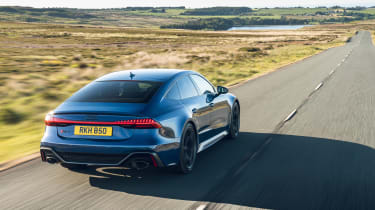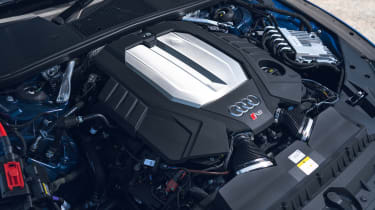Audi RS7 Sportback Performance review – engine, gearbox and technical highlights
Ostensibly the engine and transmission are not dissimilar to those of the RS7 that came before, or indeed its key rivals
The RS7 Performance’s power comes from a revised version of Audi’s 4-litre, twin-turbocharged V8 TFSI unit, with cylinder-on-demand technology and a 48V mild-hybrid system to reduce fuel consumption.
The Performance-spec V8 gains bigger turbos than before, with power now up to 621bhp – a gain of 29bhp – and torque rated at 627lb ft. The engine is still attached to an eight-speed Tiptronic automatic transmission, with power sent to all four wheels through a mechanical centre diff and a locking ‘Sport differential’ at the rear axle to apportion drive. The standard torque split is 40:60 front-to-rear, while the centre diff can delegate up to 70 per cent of drive to the front wheels or 85 per cent to the rear if the situation calls for it.
The mild-hybrid technology – a glorified term for a belt-driven starter-alternator – is primarily there to reduce load on the powertrain, rather than providing any real assistance, but combined with cylinder-on-demand tech is good for fuel savings of around a fifth of a gallon every 62 miles.
The RS7 Performance is offered with two suspension options that quite dramatically change the way it feels on the road. The standard set-up is an air spring and adaptive damper combination, with adjustable ride heights depending on driver mode. It’s the optional Dynamic Ride Control system that is unique to these large RS Audis though, with a combination of hydraulically cross-linked dampers and steel coil springs giving the RS7 more resolute control. Weight saving measures such as reduced sound deadening and lighter 22-inch alloys trim the Performance model down to 2065kg – hardly a flyweight, but comparable to rivals.
The RS7's axles are 80mm wider across both ends than the standard A7’s, so too are the suspension mounting points, while there are much stiffer bushes in the wheel carriers and upper suspension arms. The layout is actually quite simple, lacking the double-wishbone front suspension design of key rivals, but the set-up is so beefy it hardly seems to matter.
The ceramic brake package pairs massive 420mm front discs with ten-piston calipers; the rears have a smaller 380mm disc and six-piston combination. There's also four-wheel steering, which is fully 3D mapped so isn’t just programmed to give you a certain angle at certain speeds, as earlier systems did.
Now its behaviour changes constantly depending on load, steering input, speed and a multitude of other factors. Depending on how you’re cornering, in other words, those rear wheels could be pointing in the same direction, or the opposite direction to the fronts – whatever is optimal for a given scenario.





